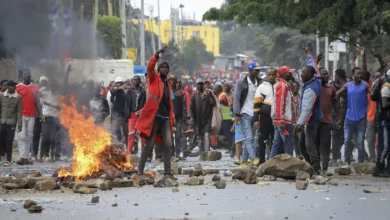A spate of kidnappings of international aid workers and the subsequent suspension of aid services to refugees is drastically reducing the role of humanitarian aid in Somalia and Kenya, where a severe drought has left tens of thousands dead and more than 2 million people displaced.
The kidnapping of three aid workers from the Denmark-based Danish Demining Group (DDG) last month, during their first demining mission to the region, has shocked an aid community that was already reeling from the kidnapping of two Spanish women working for Doctors Without Borders weeks earlier.
These kidnappings were preceded by two separate abductions of Western tourists in East Africa. In early September, two British tourists were kidnapped from their resort. A French tourist was kidnapped and killed in Somalia in October.
Despite the media attention, attacks have not been limited to tourists and foreign aid workers. Local aid workers suffer many risks as well. In mid-September, a Kenyan driver for CARE Kenya was abducted, and in August a national aid worker for the Red Cross was shot and killed by militants in Somalia.
NGOs and aid organizations are responding to the recent series of kidnappings and violence by halting “non-essential” services like psychological counseling and education and limiting aid to the most basic needs like food and water, thus reducing the services available to the severely impoverished and malnourished drought victims and refugees.
Arming workers with escorts
Most international organizations operating in the region generally encourage their aid workers to live in guarded compounds. It is not uncommon for workers to be escorted by armed guards when they leave these residences or their offices.
Sonia Aguilar, spokesperson for the United Nations refugee agency (UNHCR), told Al-Masry Al-Youm that the Kenyan State Security Forces have provided armed escorts in the refugee camps for the agency. Aguilar also said any humanitarian services suspended as a result of the kidnappings would resume after an increase of Kenyan police on the ground.
Other aid groups use armed personnel in their aid operations, as well. MSF Spain reports that it generally maintains a policy against the use of armed escorts to distinguish themselves from other armed parties. Somalia is the exception to this policy — the organization has hired armed guards to protect workers there since the 1990s.
Yet, the question of whether or not armed escorts heighten security for aid workers or make them more vulnerable is contested.
Dr. Abdiqani Sheikh Omar, a Somali doctor and the executive director for the Somali Young Doctors Association casts doubt onto whether all the bodyguards that aid organizations hire are reputable and helpful.
“[Aid organizations] get bodyguards which are not fully registered with the official government… and sometimes these bodyguards are the ones who try to kidnap the aid workers because they contact the kidnappers and forward them information,” he said.
He claims that some bodyguards are associated with clan militias in the region and are money hungry, creating an atmosphere that can leave aid workers susceptible to violence and kidnapping.
His suggestion is in line with the suspicions of many in the local community of Puntland who told Somalia Report that security guards were involved in the last month’s kidnapping of the DDG workers. Somalia Report also reported that police arrested four suspects in connection to the kidnapping, including the head of the security team charged with protecting the workers.
Similarly, Abby Stoddard, a fellow with the Center for International Cooperation, said that in earlier years many international aid organizations in the region relied on clan-based local militia groups and business interests for security.
A 2009 report co-authored by Stoddard on security for humanitarian organizations found that Somalia had the highest percentage of humanitarian aid organizations using private security providers. The report stated that particularly in “south-central Somalia armed guards and escorts are omnipresent, and using them is widely viewed as the only possible way in which work can continue.”
The recent kidnappings are raising more questions about the reliability and usefulness of security escorts in Somalia and northern Kenyan.
Increasing insecurity, increasing arms?
The growing atmosphere of insecurity for aid workers and the increase in the number of obstructions to aid, even with this additional armed protection, is prompting some in the aid community to reassess the security strategies used to protect their staff and sustain aid services.
Although many aid organizations use armed security in Somalia, a large part of the international humanitarian aid community have taken great pains to emphasize their stance against the militarization of aid and their avoidance of armed escorts in conflict areas as a general rule.
Just days after their colleagues were kidnapped in early October, MSF sent out a press release stating their steadfast opposition to the use of force in freeing their captured workers. The International Committee of the Red Cross (ICRC) also has a publicly stated it prefers not use armed escorts whenever possible to gain credibility and convey neutrality.
“Many assume an increase in use of governments and military personnel using development activities for stabilization or counterinsurgency, such as in Somalia, create more confusion about whether aid workers are simply an extension of the military,” Lisa Schirch, a research professor with Center for Justice & Peace-building at Eastern Mennonite University, said. “Aid workers see this shrinking of humanitarian and civil society space as making NGOs the ‘soft target’ for armed opposition groups.”
Some aid workers fear this loss of the perception of neutrality will put them and their operations at risk and ultimately prevent them from reaching victims in need.
Accusations against international aid groups are often based on the belief that aid organizations are covertly working for a government or the military. These claims gain traction with highly-publicized incidents such as the alleged fake CIA vaccination clinics set up to extract DNA data from patients in attempt to locate and assassinate Osama bin Laden. For many in the humanitarian community, images of armed escorts only serve to exacerbate these claims.
Yet, as the situation in Somalia and Kenya becomes more unstable, calls for more armed security for aid workers and humanitarian spaces will likely increase.
While this debate is particularly relevant for aid workers in the Horn of Africa, many of these aid organizations are witnessing an upsurge in attacks across the globe.
Pierre Krahenbuhl, director of operations for the ICRC, argued against the militarization of aid in an article published on the ICRC website in February. He insisted that even as deliberate attacks against aid workers become more common, humanitarian aid organizations should not always resort to arming themselves in order to deliver services.
“Aid agencies cannot have it both ways: asking for armed escorts to reach populations in need one day and criticizing those same military forces for blurring the lines the next cannot be a solution…this very inconsistency creates further problems in terms of perception and trust. Humanitarians cannot simply point fingers and exclude their own choices and actions from the debate,” he wrote.
While recent media attention on aid workers highlights their dilemma, the consensus among most aid organizations is that those who suffer the most from the loss of security are the victims of the drought and warfare.
As a consequence Somalis and Kenyans continue to endure not only drought, terrorist attacks, and military operations but they also face the loss of services as humanitarian activities in the region become more insecure.




